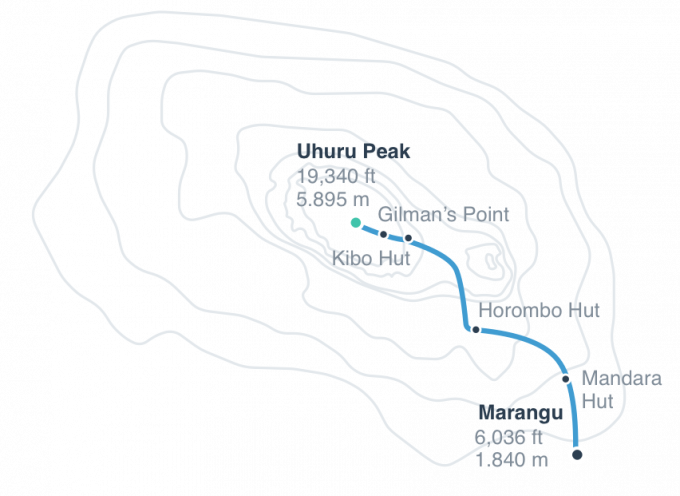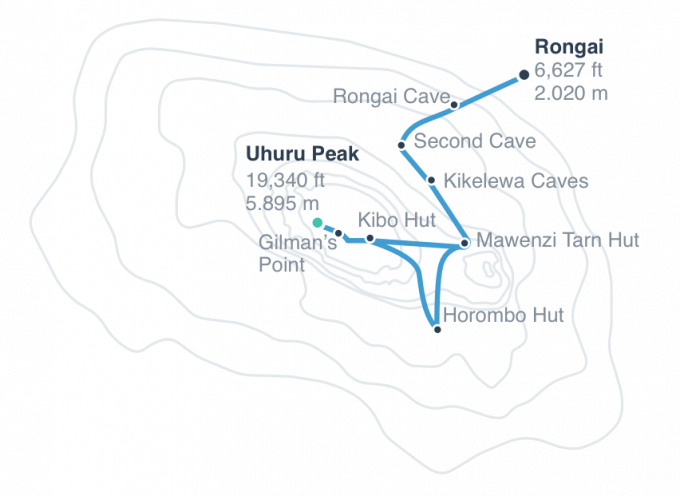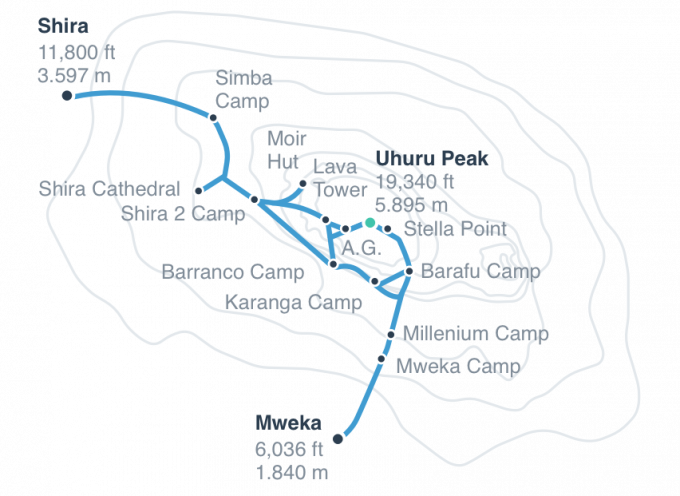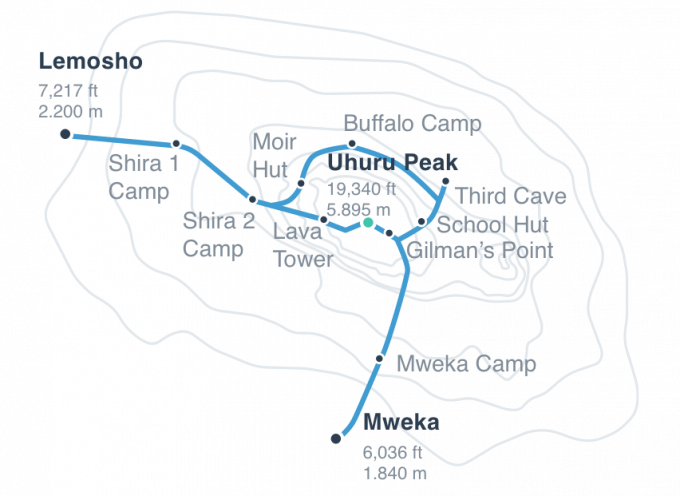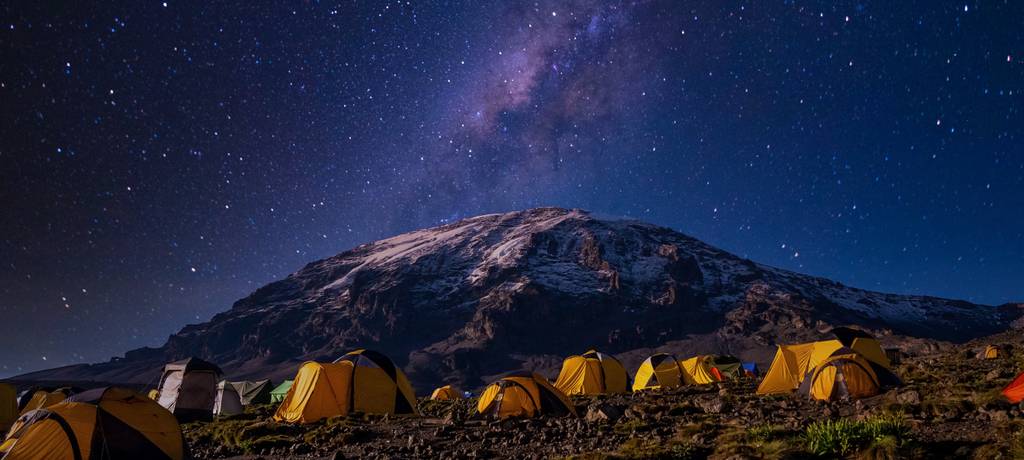
Climbing Mount Kilimanjaro
Standing at a height of 5,895m, Mount Kilimanjaro is one of the most coveted hiking destinations in the world, and holds the title as Africa’s highest freestanding mountain. Whether you’re mastering the basic techniques, or if you’ve been scrambling across mountains from the moment you could walk, this dormant volcano offers a variety of routes for all skill levels and mountaineering prowess.
How to Climb Mount Kilimanjaro
How do I prepare for Mount Kilimanjaro?
Any physical activity you participate in before you embark on the trek of a lifetime will only help to make your ascent more enjoyable. As for how hard you train, this will depend on whether you're aiming for the Uhuru Peak, or embarking on a shorter journey and this will be different for everyone.
Learn more.When should I climb Mount Kilimanjaro?
You can climb Mount Kilimanjaro year-round, but it may be wet and cold which means you should be equipped with the correct waterproof gear. Consider climbing between January–March and June–October. Note that April, May and November are the wettest months.
Learn more.What permits do I need?
Each visitor will be required to pay a fee per day for the conservation fee to help manage the national park. Most tours, however, will cover the permits and entry fees included in the price.
Learn more.Do I need a guide to climb?
Yes. All hikes and treks on Mount Kilimanjaro can only be completed with a licensed guide. Depending on what route you take, the assistance of porters is likely to be included in your tour price.
How much does it cost to climb Mount Kilimanjaro?
The cost of climbing Kilimanjaro may vary depending on a season, the route you choose and the length of the journey. Usually, the prices start at $1,000 USD and above, however, this may vary if you need to purchase any extra equipment, accommodation or add any additional transportation.
What should I pack and what equipment do I need?
While trekking tour operators might supply some of the gear you’ll need, there are a few non-negotiables that you will need including waterproof clothing, a headlamp, sunglasses, appropriate hiking boots, personal medication, a non-disposable water bottle, and a beanie for example. Learn more.
Mount Kilimanjaro Maps & Routes

Machame Route
Known as the most popular climbing route on Kilimanjaro, Machame is classified as a difficult route due to its steep ascent, and each day tends to cover more distance compared to the Marangu route. Because of it’s challenging nature, Machame tends to attract adventurous and experienced hikers.Read more
- Distance: 62 km
- Average duration: 6-7 days
- Average difficulty: A 7-day hike often shows a higher success rate of approximately 85%. A 6-day hike generally shows a lower success rate of 70%. Less experienced hikers are advised not to rush and aim at 7-day hike for higher chances of reaching the summit.

Marangu Route
If you’re searching for the most ‘iconic’ trek, the Marangu route is the oldest marked trail. The gradual slope appeals to many travellers as it's considered the easiest route, and is the only Kilimanjaro route that offers hut accommodation. It’s recommended to allow for one extra night to acclimatise.Read more
- Distance: 72 km
- Average duration: 5-6 days
- Average difficulty: Marangu route has one of the lowest summit success rates of all the routes up the mountain. Although it is known as the easiest trekking route, the summit success rate is sometimes as low as 50% when travellers undertake a shorter hike.

Lemosho Route
Starting in a similar direction to the Shira route, climbers are likely to encounter lower traffic on the trails until the route meets with the Machame route. Lemosho is known as one of the most beautiful routes as it includes hiking through the rainforest, past the Shira Plateau and through vast icefields.Read more
- Distance: 70 km
- Average duration: 7-8 days
- Average difficulty: The success rates are high, and the longer you take to complete the journey often shows a higher success rate. An 8-day hike usually offers around a 90% success rate while a 7-day hike will be around 85%. For a 6-day hike, the success rate will be much lower at approximately 65%.

Rongai Route
Starting from the northern side of Kilimanjaro, Rongai is the only route that travels from this direction, and is often less crowded than Marangu. Rongai is considered a moderately difficult route recommended for less experienced hikers.Read more
- Distance: 73 km
- Average duration: 6-7 days
- Average difficulty: This route is considered difficult as it does not offer the same climb height. The longer you take to complete this trail, the higher the success rate will be. A 7-day hike often sees an 80% success rate, and a 6-day hike is much lower at 65%.

Shira Plateau Route
Boasting similar qualities to the Lemosho route, the Shira route also approaches Kilimanjaro from the west. Hikers should take note of the steep elevation on this route, as day one catapults you to some serious altitude.Read more
- Distance: 56 km
- Average duration: 7-8 days
- Average difficulty: Shira has an excellent success rate. However, it should only be tackled by more experienced climbers or those who are comfortable with their ability to acclimatise as the first day is incredibly steep.

Umbwe Route
One of the most difficult, and most demanding routes on Kilimanjaro, Umbwe also happens to be the most spectacular. This short and steep route is only recommended for experienced climbers who are confident in their ability to adapt to the altitude.Read more
- Distance: 53 km
- Average duration: 5-6 days
- Average difficulty/success rate: As the most difficult and demanding trek on Mount Kilimanjaro, Umbwe has a much lower success rate than the other trails. This route should only be attempted if you are an experienced or confident hiker.

Northern Circuit Route
The Northern Circuit route follows the Lemosho trail at the start before travelling along the northern slopes where trekkers can enjoy more space on the trails.Read more
- Distance: 98 km
- Average duration: 8-9 days
- Average difficulty: Because of its length, the Northern Circuit is one of the most successful routes for reaching the summit and sees a success rate of almost 95%.
Mount Kilimanjaro Facts
Location
Mount Kilimanjaro can be found in East Africa, and is located in the northern part of Tanzania. Mount Kilimanjaro National Park is located128 km from Arusha, or just a one hour drive from Kilimanjaro airport, and it covers an area of 1,668 sq km.
Coordinates
The Mount Kilimanjaro latitude is 3.0674° S, while the longitude is 37.3556° E.
Elevation
The elevation for Mount Kilimanjaro is 5,895m (19,341 ft).
Prominence
In topography, prominence refers to and characterizes the height of a mountain's summit by the vertical distance between it and the lowest contour line encircling it but containing no higher summit within it. The prominence for Mount Kilimanjaro is 5,885m (19,308 ft).
Parent range
When looking at a mountain range, many have sub-ranges within them and is best described as a parent-child relationship. Kilimanjaro is a freestanding mountain range, however, the East Rift mountains are considered to be the parent range.
Peak
Mount Kilimanjaro is composed of three volcanic cones: Kibo, Mawenzi and Shira. Uhuru Peak is the highest summit on Kibo's crater rim and is listed at a height of 5,895m (19,341 ft).
Length
The shortest hiking route on Mount Kilimanjaro is 53 km in length, and the longest route is 98 km.
Arrival
Mount Kilimanjaro can be accessed from the town of Moshi or Arusha, and is just an hour's drive from Kilimanjaro Airport.
Success rate
Success rates for Mount Kilimanjaro can vary from 50% to 95%, depending on the chosen route and length of the hike. On average, the Northern Circuit Route gives the highest chances of reaching the top with success rate of almost 95%, while the title of the least successful route belongs to Marangu Route, with a success rate of 50%.
Best Time to Climb Kilimanjaro
Kilimanjaro temperatures
| JAN | FEB | MAR | APR | MAY | JUN | JUL | AUG | SEP | OCT | NOV | DEC | |
|---|---|---|---|---|---|---|---|---|---|---|---|---|
| Average °F | 81 | 81 | 79 | 77 | 73 | 72 | 70 | 72 | 73 | 77 | 77 | 79 |
| Average °C | 27 | 27 | 26 | 25 | 23 | 22 | 21 | 22 | 23 | 25 | 25 | 26 |
| High °F | 91 | 91 | 88 | 84 | 81 | 79 | 79 | 81 | 84 | 88 | 88 | 90 |
| High °C | 33 | 33 | 31 | 29 | 27 | 26 | 26 | 27 | 29 | 31 | 31 | 32 |
| Low °F | 68 | 68 | 70 | 68 | 68 | 66 | 63 | 61 | 61 | 63 | 64 | 66 |
| Low °C | 20 | 20 | 21 | 20 | 19 | 17 | 16 | 16 | 17 | 18 | 18 | 19 |

